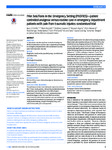PAin SoluTions In the Emergency Setting (PASTIES)--patient controlled analgesia versus routine care in emergency department patients with pain from traumatic injuries: randomised trial
| dc.contributor.author | Zhu, Chengyong | |
| dc.contributor.author | Rockett, M | |
| dc.contributor.author | Creanor, Siobhan | |
| dc.contributor.author | Squire, R | |
| dc.contributor.author | Hayward, C | |
| dc.contributor.author | Ewings, P | |
| dc.contributor.author | barton, andy | |
| dc.contributor.author | Pritchard, C | |
| dc.contributor.author | Eyre, V | |
| dc.contributor.author | Cocking, Laura | |
| dc.contributor.author | Benger, J | |
| dc.date.accessioned | 2015-10-14T16:41:36Z | |
| dc.date.available | 2015-10-14T16:41:36Z | |
| dc.date.issued | 2015-06-21 | |
| dc.identifier.issn | 0959-535X | |
| dc.identifier.issn | 1756-1833 | |
| dc.identifier.other | ARTN h2988 | |
| dc.identifier.uri | http://hdl.handle.net/10026.1/3633 | |
| dc.description.abstract |
OBJECTIVE: To determine whether patient controlled analgesia (PCA) is better than routine care in patients presenting to emergency departments with moderate to severe pain from traumatic injuries. DESIGN: Pragmatic, multicentre, parallel group, randomised controlled trial. SETTING: Five English hospitals. PARTICIPANTS: 200 adults (71% (n = 142) male), aged 18 to 75 years, who presented to the emergency department requiring intravenous opioid analgesia for the treatment of moderate to severe pain from traumatic injuries and were expected to be admitted to hospital for at least 12 hours. INTERVENTIONS: PCA (n = 99) or nurse titrated analgesia (treatment as usual; n = 101). MAIN OUTCOME MEASURES: The primary outcome was total pain experienced over the 12 hour study period, derived by standardised area under the curve (scaled from 0 to 100) of each participant's hourly pain scores, captured using a visual analogue scale. Pre-specified secondary outcomes included total morphine use, percentage of study period in moderate/severe pain, percentage of study period asleep, length of hospital stay, and satisfaction with pain management. RESULTS: 200 participants were included in the primary analyses. Mean total pain experienced was 47.2 (SD 21.9) for the treatment as usual group and 44.0 (24.0) for the PCA group. Adjusted analyses indicated slightly (but not statistically significantly) lower total pain experienced in the PCA group than in the routine care group (mean difference 2.7, 95% confidence interval -2.4 to 7.8). Participants allocated to PCA used more morphine in total than did participants in the treatment as usual group (mean 44.3 (23.2) v 27.2 (18.2) mg; mean difference 17.0, 11.3 to 22.7). PCA participants spent, on average, less time in moderate/severe pain (36.2% (31.0) v 44.1% (31.6)), but the difference was not statistically significant. A higher proportion of PCA participants reported being perfectly or very satisfied compared with the treatment as usual group (86% (78/91) v 76% (74/98)), but this was also not statistically significant. CONCLUSIONS: PCA provided no statistically significant reduction in pain compared with routine care for emergency department patients with traumatic injuries. Trial registration European Clinical Trials Database EudraCT2011-000194-31; Current Controlled Trials ISRCTN25343280. | |
| dc.format.extent | h2988-h2988 | |
| dc.format.medium | Electronic | |
| dc.language | en | |
| dc.language.iso | en | |
| dc.publisher | BMJ | |
| dc.subject | Adolescent | |
| dc.subject | Adult | |
| dc.subject | Aged | |
| dc.subject | Aged, 80 and over | |
| dc.subject | Analgesia, Patient-Controlled | |
| dc.subject | Emergency Service, Hospital | |
| dc.subject | Emergency Treatment | |
| dc.subject | Female | |
| dc.subject | Humans | |
| dc.subject | Male | |
| dc.subject | Middle Aged | |
| dc.subject | Pain | |
| dc.subject | Pain Management | |
| dc.subject | Wounds and Injuries | |
| dc.subject | Young Adult | |
| dc.title | PAin SoluTions In the Emergency Setting (PASTIES)--patient controlled analgesia versus routine care in emergency department patients with pain from traumatic injuries: randomised trial | |
| dc.type | journal-article | |
| dc.type | Comparative Study | |
| dc.type | Journal Article | |
| dc.type | Multicenter Study | |
| dc.type | Randomized Controlled Trial | |
| dc.type | Research Support, Non-U.S. Gov't | |
| plymouth.author-url | https://www.webofscience.com/api/gateway?GWVersion=2&SrcApp=PARTNER_APP&SrcAuth=LinksAMR&KeyUT=WOS:000377712900001&DestLinkType=FullRecord&DestApp=ALL_WOS&UsrCustomerID=11bb513d99f797142bcfeffcc58ea008 | |
| plymouth.issue | jun19 2 | |
| plymouth.volume | 350 | |
| plymouth.publication-status | Published | |
| plymouth.journal | BMJ | |
| dc.identifier.doi | 10.1136/bmj.h2988 | |
| plymouth.organisational-group | /Plymouth | |
| plymouth.organisational-group | /Plymouth/Faculty of Health | |
| plymouth.organisational-group | /Plymouth/Faculty of Health/Peninsula Medical School | |
| plymouth.organisational-group | /Plymouth/Faculty of Health/Peninsula Medical School/PMS - Manual | |
| plymouth.organisational-group | /Plymouth/REF 2021 Researchers by UoA | |
| plymouth.organisational-group | /Plymouth/REF 2021 Researchers by UoA/UoA03 Allied Health Professions, Dentistry, Nursing and Pharmacy | |
| plymouth.organisational-group | /Plymouth/Research Groups | |
| plymouth.organisational-group | /Plymouth/Research Groups/Institute of Health and Community | |
| plymouth.organisational-group | /Plymouth/Research Groups/Institute of Translational and Stratified Medicine (ITSMED) | |
| plymouth.organisational-group | /Plymouth/Research Groups/Institute of Translational and Stratified Medicine (ITSMED)/CBBB | |
| plymouth.organisational-group | /Plymouth/Research Groups/Institute of Translational and Stratified Medicine (ITSMED)/CCT&PS | |
| plymouth.organisational-group | /Plymouth/Research Groups/Plymouth Institute of Health and Care Research (PIHR) | |
| plymouth.organisational-group | /Plymouth/Users by role | |
| plymouth.organisational-group | /Plymouth/Users by role/Academics | |
| dc.publisher.place | England | |
| dcterms.dateAccepted | 2015-05-08 | |
| dc.identifier.eissn | 1756-1833 | |
| dc.rights.embargoperiod | Not known | |
| rioxxterms.versionofrecord | 10.1136/bmj.h2988 | |
| rioxxterms.licenseref.uri | http://www.rioxx.net/licenses/all-rights-reserved | |
| rioxxterms.licenseref.startdate | 2015-06-21 | |
| rioxxterms.type | Journal Article/Review |


